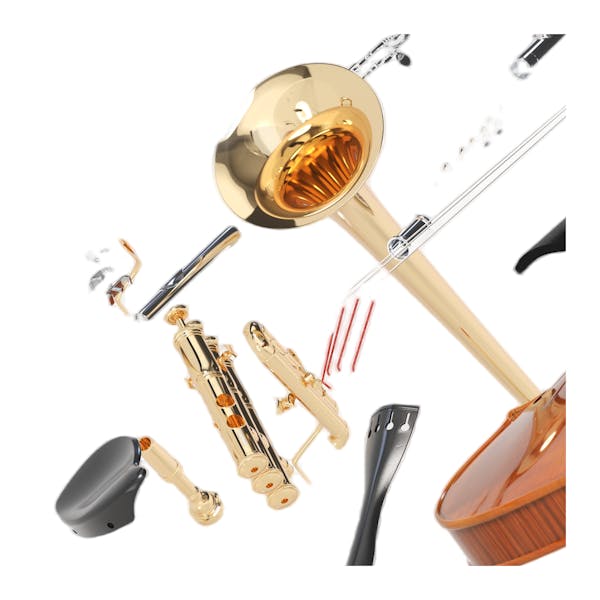Kepler Orchestra
Explore a new sonic universe
Explore a new sonic universe
Discover your new secret weapon for writing cutting-edge film, TV and game scores. Kepler Orchestra makes it easy to evoke movement, speed and atmosphere by creating interlocking orchestral rhythms – from simple to massively complex. Our new Systems Grid does the hard work for you, with repeated notes, doppler effects, swells and shards. Similarly, our Mercury Synth engine expands your sonic universe with warped and space-inspired sounds.
Recorded at AIR Studio One and featuring a chamber-sized orchestra, Kepler Orchestra is inspired by the great American systems composers of the late 20th century: Terry Riley, Philip Glass, Steve Reich and John Adams.
In this page:
- Hard drive delivery available at checkout
- You can buy now and download any time
 Spitfire Audio App required
Spitfire Audio App required
74 players
54 articulations
Kontakt Player
Listen to Kepler Orchestra
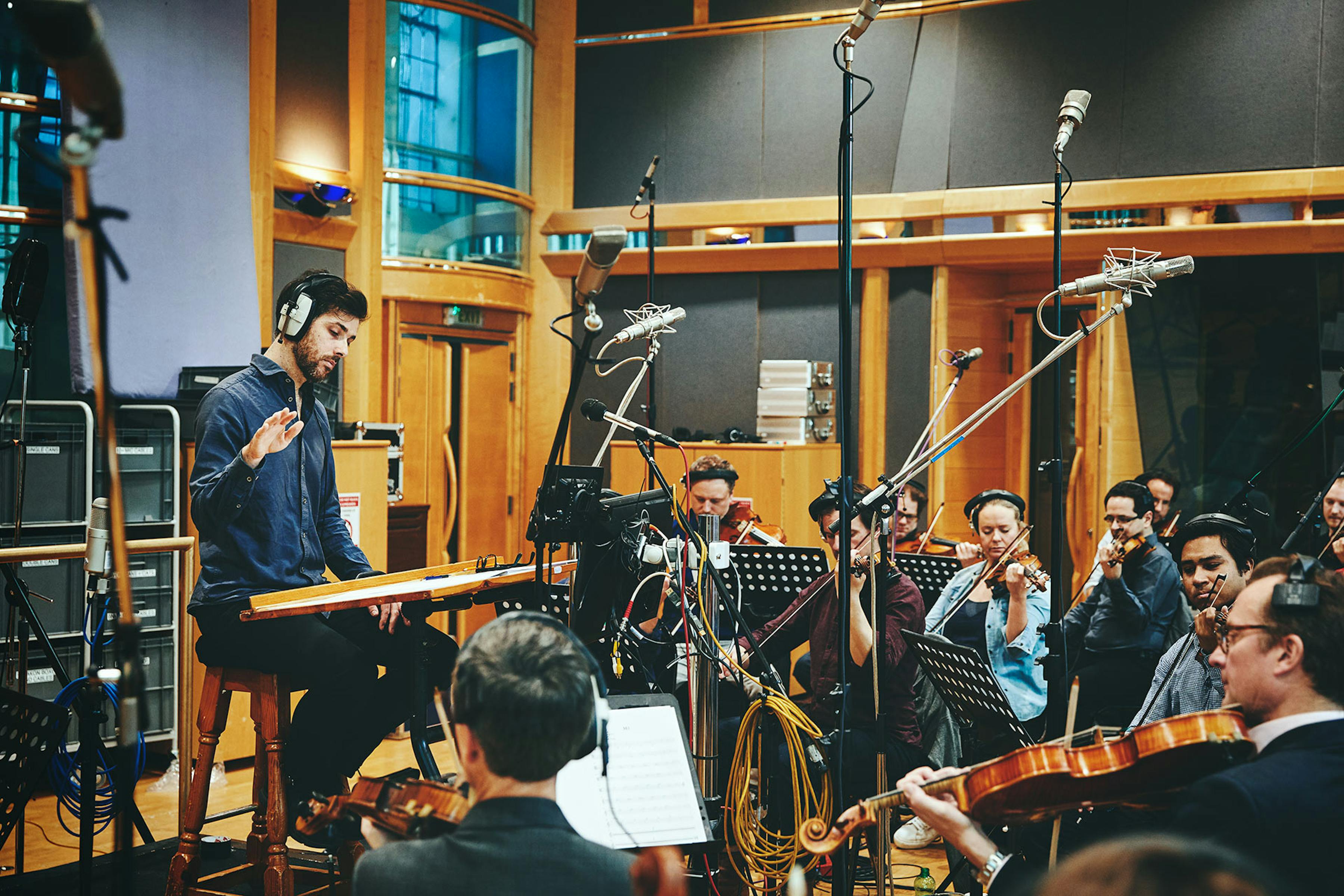
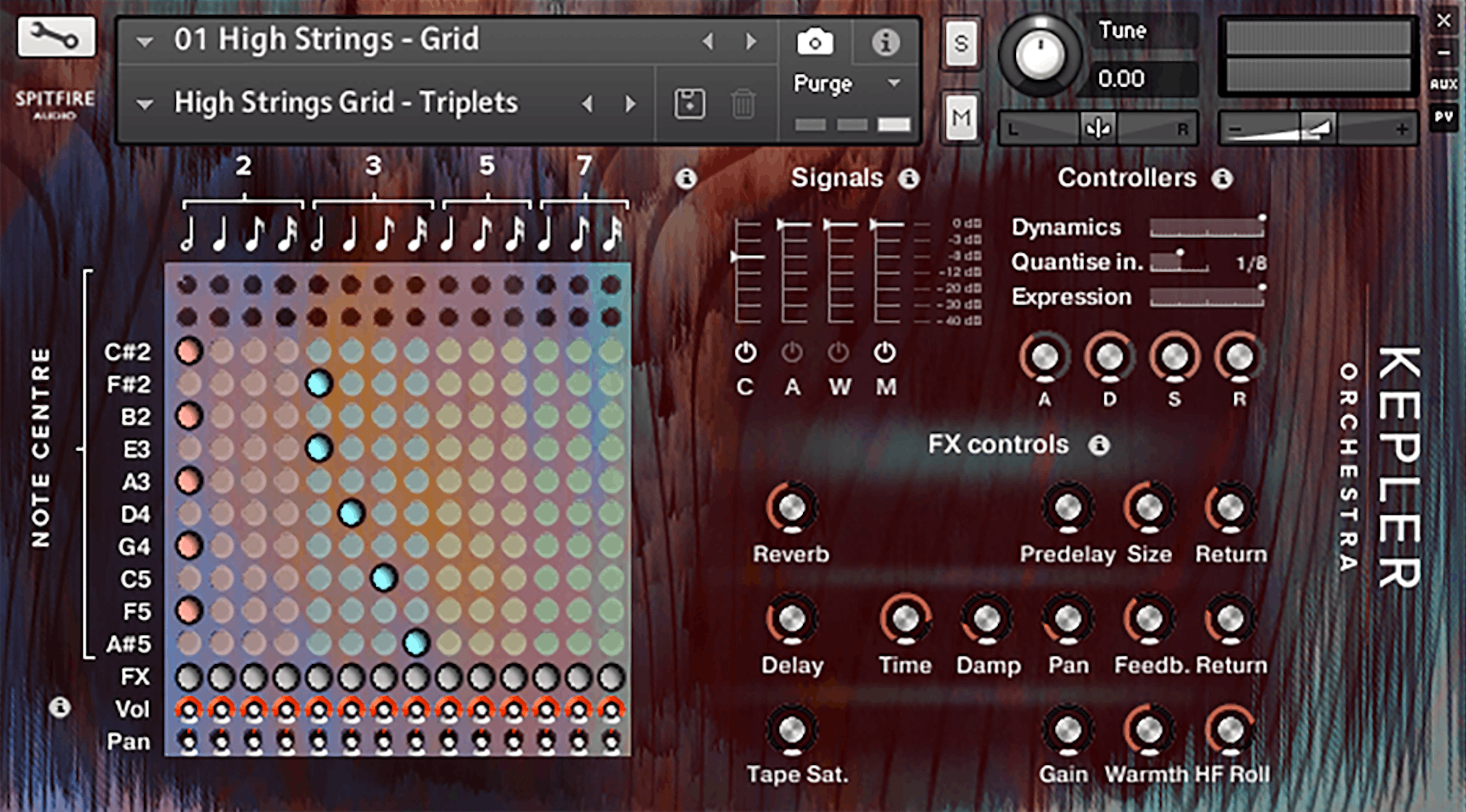
The systems grid
Together with a wide range of innovative and nuanced articulations (from repeated notes, to doppler effects, swells, shards and pulsing movements), our sophisticated Systems Grid, based on our hugely successful Evo Grid technology, has solved a common problem for composers — it allows you to create realistic sounding, complex interlocking polyrhythms — the simultaneous combination of contrasting rhythms — that are impossible to successfully produce using traditional samples.
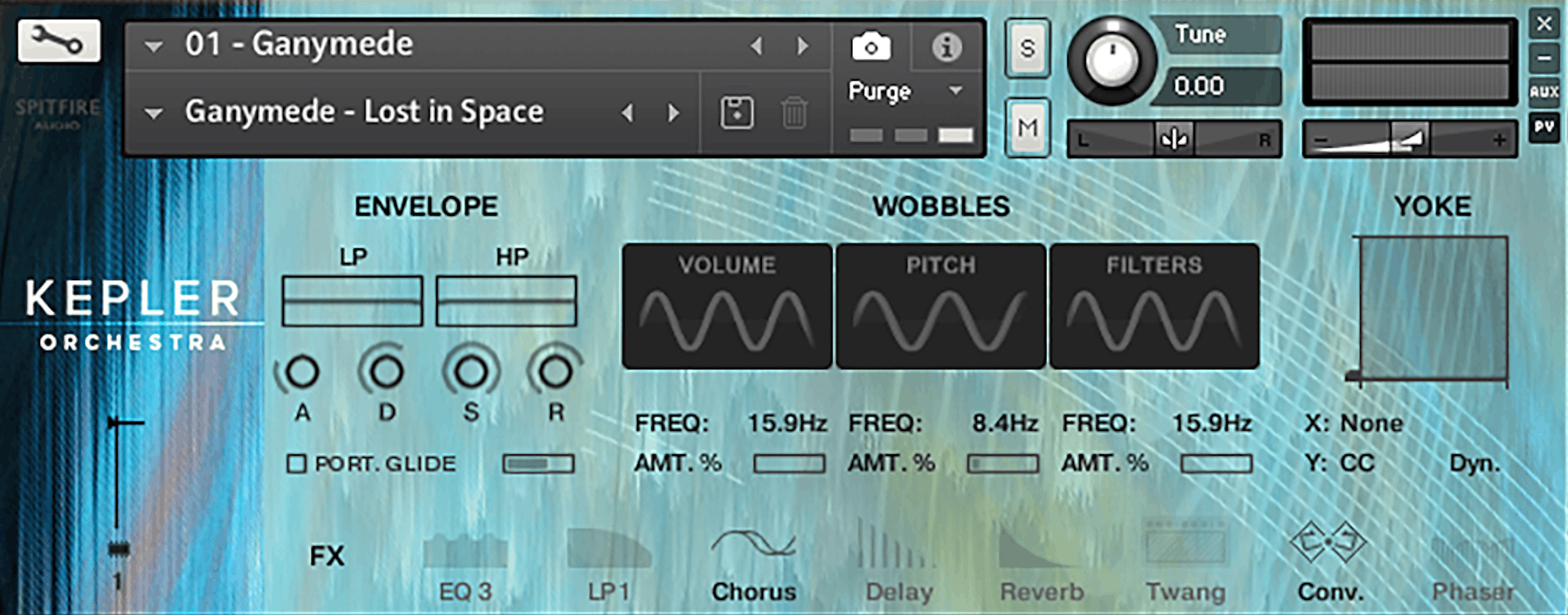
This is not a phrase library, or a series of evolutions — it is a set of detailed and sophisticated articulations and raw materials, designed to give you the power to create your own complex, nuanced phrases with ease and control. Kepler Orchestra can however interpret your music and play it in ways you never expected.

Dopplers
The Doppler Effect is the change in frequency of a wave as the source and observer move toward or away from each other, for example, what you hear when an ambulance passes by, or the red shift in light observed by astronomers. We have recreated this by recording notes that grow, bend down by a semitone and die away, so they sound like they are shooting past you.
Shards
Our shards grid is inspired by light particles, reminiscent of shards of light, or the light spun out at the creation of an accretion disk. The result is swells of sound that rise dramatically in dynamic until they stop dead.
Momentum
Our momentum grid is inspired by light wave interference theory — notes that increase and decrease in both speed and dynamic, from pulsing to accelerating.
Warped
The Warped section contains thirty contrasting sounds to add an extra layer of cosmic depth and atmosphere to your polyrhythmic compositions. Each of these sounds was produced using the organic sample content from the library, designed to add unique depth, texture and atmosphere to any composition. Some samples were made using granular synthesis, while others were pumped through outboard gear, distressors, reverbs, saturators, and guitar FX pedals to create something completely new and original. Presented in our Mercury synth, all of the controls are assignable to your control surface, giving you the immediate ability to make our sounds your own.
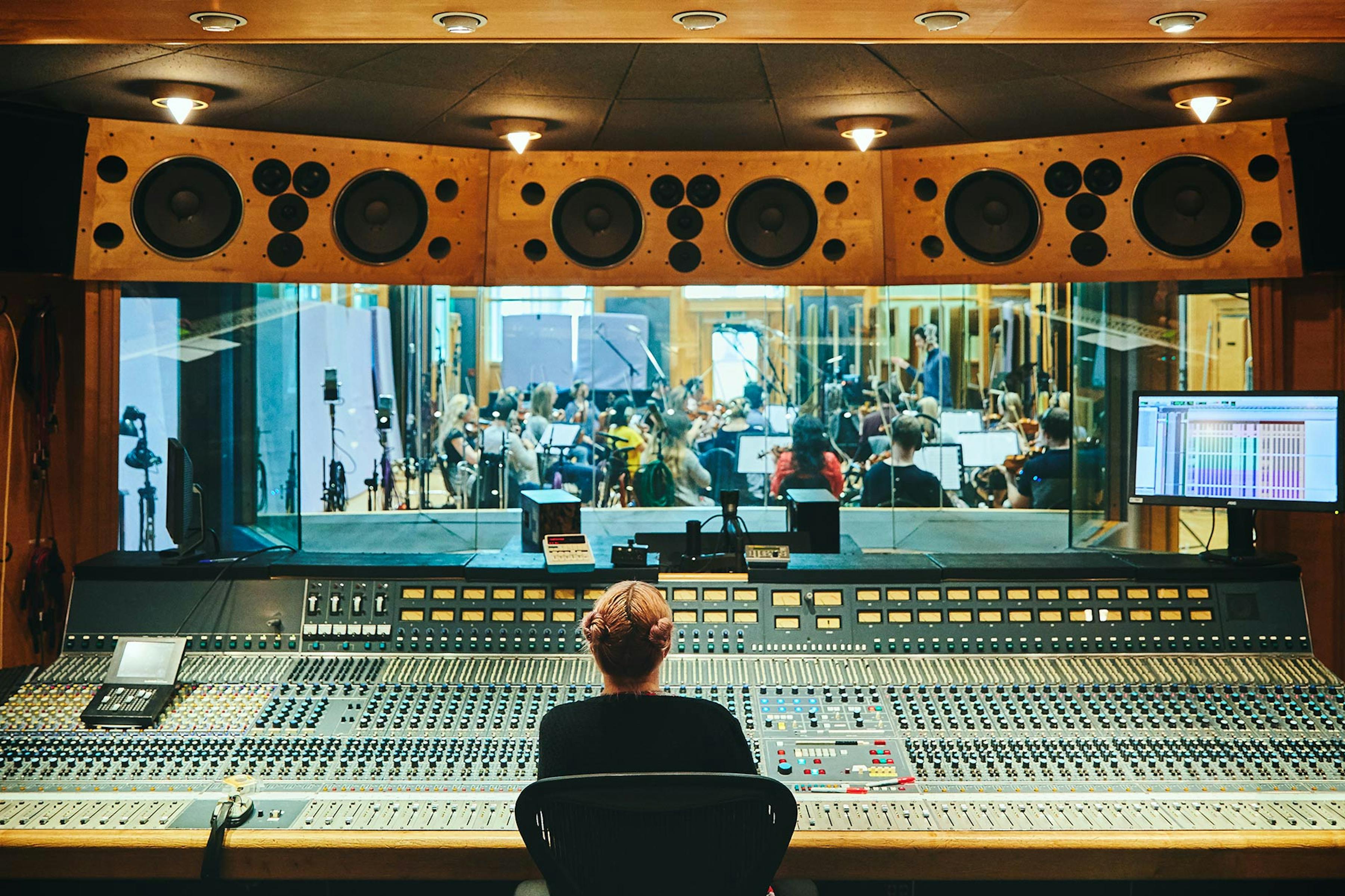
The great systems composers of the 20th century such as Riley, Reich, Glass & Adams have had a huge influence on modern music, inspiring composers and artists the world over, from Kraftwerk, Led Zeppelin and Tangerine Dream to Sufjan Stevens, Nils Frahm and Cliff Martinez. Systems music at its core is based on repeated sounds with contrasting rhythmic subdivisions that move in and out of sync, reminiscent of planetary motion — each planet on its own journey, but working together in perfect harmony.
Inspired by this concept, composer and Spitfire Audio co-founder Paul Thomson had the vision of sampling a set of innovative and versatile orchestral articulations and playing styles, cyclical in nature, with the aim of enabling composers to score ultra-realistic repeated notes and complex polyrhythms using samples.
Johannes Kepler was a German astronomer and mathematician, famous for his three laws of planetary motion. Knowledge of these laws, especially the area law, provided the foundation for Sir Isaac Newton’s famous law of gravitation. Kepler was convinced "that the geometrical things have provided the Creator with the model for decorating the whole world". In Harmony, he attempted to explain the proportions of the natural world — particularly the astronomical and astrological aspects — in terms of music. The central set of "harmonies" was the musica universalis or "music of the spheres", which had been studied by Pythagoras, Ptolemy and many others before him.
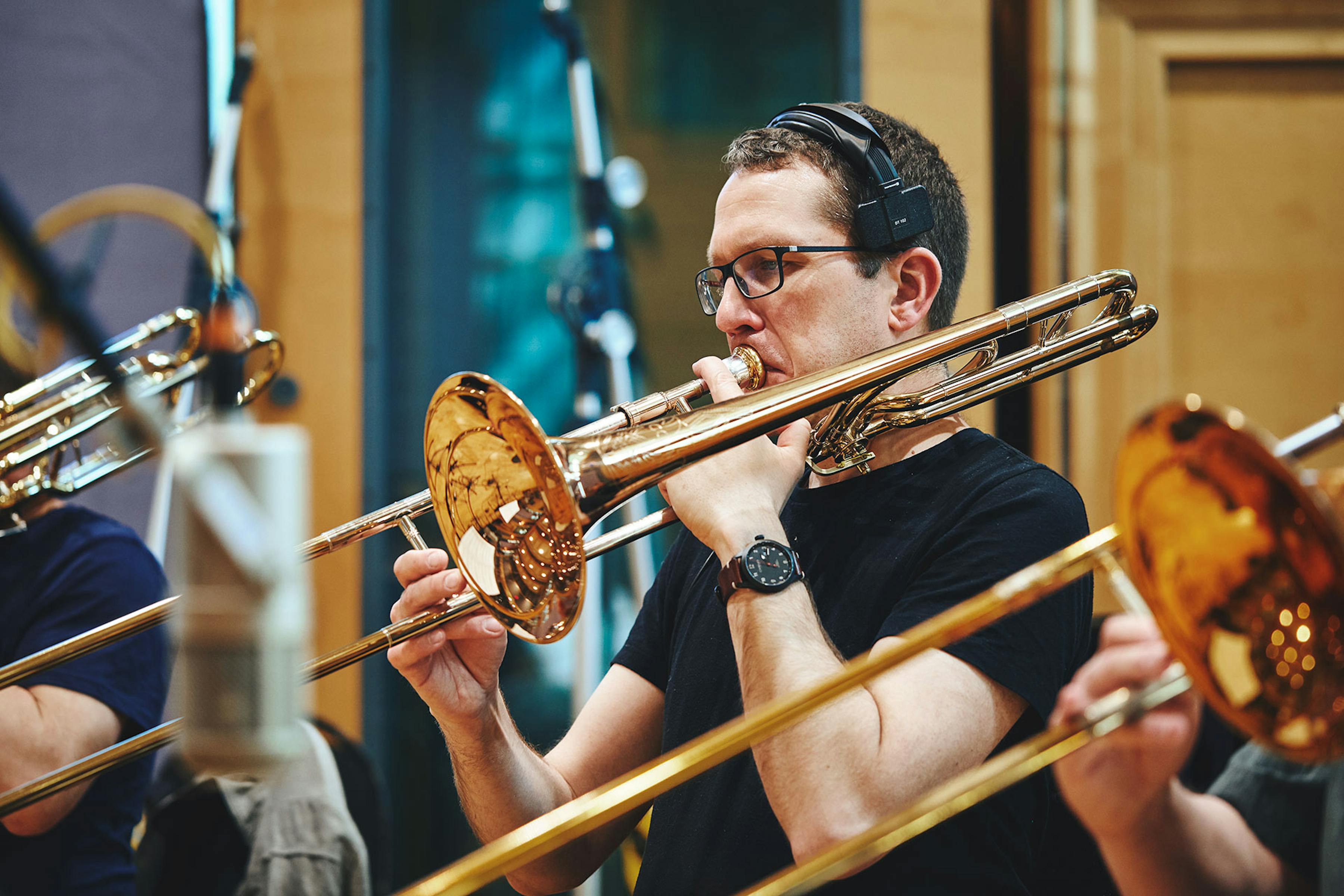
What's included
Instruments
High strings
- 9 grids
- 9 mix grids
- 58 snapshots (29 for grid, 29 for mix grid)
Celli
- 13 grids
- 13 mix grids
- 76 snapshots (38 for grid, 38 for mix grid)
High brass
- 6 grids
- 6 mix grids
- 38 snapshots (19 for grid, 19 for mix grid)
Low brass
- 10 grids
- 10 mix grids
- 46 snapshots (23 for grid, 23 for mix grid)
Basses
- 11 grids
- 11 mix grids
- 62 snapshots (31 for grid, 31 for mix grid)
Woodwinds
- 5 grids
- 5 mix grids
- 28 snapshots (14 for grid, 14 for mix grid)
Warped
- 30 patches
- 105 snapshots
High strings
- High strings - grid
- High strings - muted grid
- High strings - sul pont grid
- High strings - muted tremolo grid
- High strings - momentum grid
- High strings - pulsing momentum grid
- High strings - accelerating momentum grid
- High strings - shards grid
- High strings - shards grid time machine
- High strings - grid (mix)
- High strings - muted grid (mix)
- High strings - sul pont grid (mix)
- High strings - muted tremolo grid (mix)
- High strings - momentum grid (mix)
- High strings - pulsing momentum grid (mix)
- High strings - accelerating momentum grid (mix)
- High strings - shards grid (mix)
- High strings - shards grid time machine (mix)
Celli
- Celli - grid
- Celli - muted grid
- Celli - sul pont grid
- Celli - muted tremolo grid
- Celli - momentum grid
- Celli - pulsing momentum grid
- Celli - accelerating momentum grid
- Celli - shards grid
- Celli - dopplers grid
- Celli - non pulsing dopplers grid
- Celli - shards grid time machine
- Celli - dopplers grid time machine
- Celli - non pulsing dopplers grid time machine
- Celli - grid (mix)
- Celli - muted grid (mix)
- Celli - sul pont grid (mix)
- Celli - muted tremolo grid (mix)
- Celli - momentum grid (mix)
- Celli - pulsing momentum grid (mix)
- Celli - accelerating momentum grid (mix)
- Celli - shards grid (mix)
- Celli - dopplers grid (mix)
- Celli - non pulsing dopplers grid (mix)
- Celli - shards grid time machine (mix)
- Celli - dopplers grid time machine (mix)
- Celli - non pulsing dopplers grid time machine (mix)
High brass
- High brass - grid
- High brass - momentum grid
- High brass - pulsing momentum grid
- High brass - accelerating momentum grid
- High brass - shards grid
- High brass - shards grid time machine
- High brass - grid (mix)
- High brass - momentum grid (mix)
- High brass - pulsing momentum grid (mix)
- High brass - accelerating momentum grid (mix)
- High brass - shards grid (mix)
- High brass - shards grid time machine (mix)
Low brass
- Low brass - grid
- Low brass - momentum grid
- Low brass - pulsing momentum grid
- Low brass - accelerating momentum grid
- Low brass - shards grid
- Low brass - dopplers grid
- Low brass - non pulsing dopplers grid
- Low brass - shards grid time machine
- Low brass - dopplers grid time machine
- Low brass - non pulsing dopplers grid time machine
- Low brass - grid (mix)
- Low brass - momentum grid (mix)
- Low brass - pulsing momentum grid (mix)
- Low brass - accelerating momentum grid (mix)
- Low brass - shards grid (mix)
- Low brass - dopplers grid (mix)
- Low brass - non pulsing dopplers grid (mix)
- Low brass - shards grid time machine (mix)
- Low brass - dopplers grid time machine (mix)
- Low brass - non pulsing dopplers grid time machine (mix)
Basses
- Basses - grid
- Basses - pizzicato grid
- Basses - col legno grid
- Basses - tremolo grid
- Basses - momentum grid
- Basses - harmonics grid
- Basses - tremolo harmonics grid
- Basses - shards grid
- Basses - dopplers grid
- Basses - shards grid time machine
- Basses - dopplers grid time machine
- Basses - grid (mix)
- Basses - pizzicato grid (mix)
- Basses - col legno grid (mix)
- Basses - tremolo grid (mix)
- Basses - momentum grid (mix)
- Basses - harmonics grid (mix)
- Basses - tremolo harmonics grid (mix)
- Basses - shards grid (mix)
- Basses - dopplers grid (mix)
- Basses - shards grid time machine (mix)
- Basses - dopplers grid time machine (mix)
Woodwinds
- Woodwinds - grid
- Woodwinds - momentum grid
- Woodwinds - accelerating momentum grid
- Woodwinds - shards grid
- Woodwinds - shards grid time machine
- Woodwinds - grid (mix)
- Woodwinds - momentum grid (mix)
- Woodwinds - accelerating momentum grid (mix)
- Woodwinds - shards grid (mix)
- Woodwinds - shards grid time machine (mix)
Warped
- Ganymede
- Callisto
- Titan
- Io
- Europa
- Triton
- Rhea
- Oberon
- Umbriel
- Dione
- Ariel
- Charon
- Iapetus
- Mimas
- Hyperion
- Proteus
- Amalthea
- Himalia
- Janus
- Epimetheus
- Portia
- Larissa
- Galatea
- Despina
- Caliban
- Ophelia
- Hydra
- Calypso
- Atlas
- Tethys
Snapshots
Ganymede
- Ganymede - default
- Ganymede - fake grid
- Ganymede - lost in space
- Ganymede - phaser
- Ganymede - short fizzer
Basses - grid
- Basses grid - duplets
- Basses grid - quintuplets
- Basses grid - septuplets
- Basses grid - time madness
- Basses grid - triplets
- Basses grid (mix) - duplets
- Basses grid (mix) - quintuplets
- Basses grid (mix) - septuplets
- Basses grid (mix) - time madness
- Basses grid (mix) - triplets
Celli - Grid
- Celli grid - duplets
- Celli grid - quintuplets
- Celli grid - septuplets
- Celli grid - time madness
- Celli grid - triplets
- Celli grid (mix) - duplets
- Celli grid (mix) - quintuplets
- Celli grid (mix) - septuplets
- Celli grid (mix) - time madness
- Celli grid (mix) - triplets
High brass - Grid
- High brass grid - duplets
- High brass grid - quintuplets
- High brass grid - septuplets
- High brass grid - time madness
- High brass grid - triplets
- High brass grid (mix) - duplets
- High brass grid (mix) - quintuplets
- High brass grid (mix) - septuplets
- High brass grid (mix) - time madness
- High brass grid (mix) - triplets
High strings - Grid
- High strings grid - duplets
- High strings grid - quintuplets
- High strings grid - septuplets
- High strings grid - time madness
- High strings grid - triplets
- High strings grid (mix) - duplets
- High strings grid (mix) - quintuplets
- High strings grid (mix) - septuplets
- High strings grid (mix) - time madness
- High strings grid (mix) - triplets
Low brass - Grid
- Low brass grid - duplets
- Low brass grid - quintuplets
- Low brass grid - septuplets
- Low brass grid - time madness
- Low brass grid - triplets
- Low brass grid (mix) - duplets
- Low brass grid (mix) - quintuplets
- Low brass grid (mix) - septuplets
- Low brass grid (mix) - time madness
- Low brass grid (mix) - triplets
Woodwinds - Grid
- Woodwinds grid - duplets
- Woodwinds grid - quintuplets
- Woodwinds grid - septuplets
- Woodwinds grid - time madness
- Woodwinds grid - triplets
- Woodwinds grid (mix) - duplets
- Woodwinds grid (mix) - quintuplets
- Woodwinds grid (mix) - septuplets
- Woodwinds grid (mix) - time madness
- Woodwinds grid (mix) - triplets
Callisto
- Callisto - default
- Callisto - distorted galaxy
- Callisto - mono star
- Callisto - outer reaches
Basses - pizzicato grid
- Basses pizzicato grid - quintuplets
- Basses pizzicato grid - septuplets
- Basses pizzicato grid - time madness
- Basses pizzicato grid - triplets
- Basses pizzicato grid (mix) - quintuplets
- Basses pizzicato grid (mix) - septuplets
- Basses pizzicato grid (mix) - time madness
- Basses pizzicato grid (mix) - triplets
Celli - muted grid
- Celli muted grid - duplets
- Celli muted grid - quintuplets
- Celli muted grid - septuplets
- Celli muted grid - time madness
- Celli muted grid - triplets
Celli - muted grid (mix)
- Celli muted grid (mix) - duplets
- Celli muted grid (mix) - quintuplets
- Celli muted grid (mix) - septuplets
- Celli muted grid (mix) - time madness
- Celli muted grid (mix) - triplets
High brass - momentum grid
- High brass momentum grid - diagonal momentums
- High brass momentum grid - pulsing momentums
- High brass momentum grid - random momentums
- High brass momentum grid - tidal momentums
- High brass momentum grid (mix) - diagonal momentums
- High brass momentum grid (mix) - pulsing momentums
- High brass momentum grid (mix) - random momentums
- High brass momentum grid (mix) - tidal momentums
High strings - muted grid
- High strings muted grid - duplets
- High strings muted grid - quintuplets
- High strings muted grid - septuplets
- High strings muted grid - time madness
- High strings muted grid - triplets
- High strings muted grid (mix) - duplets
- High strings muted grid (mix) - quintuplets
- High strings muted grid (mix) - septuplets
- High strings muted grid (mix) - time madness
Low brass - momentum grid
- Low brass momentum grid - diagonal momentums
- Low brass momentum grid - pulsing momentums
- Low brass momentum grid - tidal momentums
- Low brass momentum grid (mix) - diagonal momentums
- Low brass momentum grid (mix) - pulsing momentums
- Low brass momentum grid (mix) - tidal momentums
Woodwinds - momentum grid
- Woodwinds momentum grid - diagonal momentums
- Woodwinds momentum grid - pulsing momentums
- Woodwinds momentum grid - tidal momentums
- Woodwinds momentum grid (mix) - diagonal momentums
- Woodwinds momentum grid (mix) - pulsing momentums
- Woodwinds momentum grid (mix) - tidal momentums
Titan
- Titan - arpeggiator
- Titan - default
- Titan - radio transmission
- Titan - reverse gravity
Basses - col legno grid
- Basses col legno grid - quintuplets
- Basses col legno grid - septuplets
- Basses col legno grid - time madness
- Basses col legno grid - triplets
- Basses col legno grid (mix) - quintuplets
- Basses col legno grid (mix) - septuplets
- Basses col legno grid (mix) - time madness
- Basses col legno grid (mix) - triplets
Celli - sul pont grid
- Celli sul pont grid - duplets
- Celli sul pont grid - quintuplets
- Celli sul pont grid - septuplets
- Celli sul pont grid - time madness
- Celli sul pont grid - triplets
- Celli sul pont grid (mix) - duplets
- Celli sul pont grid (mix) - quintuplets
- Celli sul pont grid (mix) - septuplets
- Celli sul pont grid (mix) - time madness
- Celli sul pont grid (mix) - triplets
High brass - pulsing momentum grid
- High brass pulsing momentum grid - diagonal momentums
- High brass pulsing momentum grid - pulsing momentums
- High brass pulsing momentum grid - random momentums
- High brass pulsing momentum grid - tidal momentums
- High brass pulsing momentum grid (mix) - diagonal momentums
- High brass pulsing momentum grid (mix) - pulsing momentums
- High brass pulsing momentum grid (mix) - random momentums
- High brass pulsing momentum grid (mix) - tidal momentums
High strings - sul pont grid
- High strings sul pont grid - duplets
- High strings sul pont grid - quintuplets
- High strings sul pont grid - septuplets
- High strings sul pont grid - time madness
- High strings sul pont grid - triplets
- High strings sul pont grid (mix) - duplets
- High strings sul pont grid (mix) - quintuplets
- High strings sul pont grid (mix) - septuplets
- High strings sul pont grid (mix) - time madness
- High strings sul pont grid (mix) - triplets
Low brass - pulsing momentum grid
- Low brass pulsing momentum grid - diagonal momentums
- Low brass pulsing momentum grid - pulsing momentums
- Low brass pulsing momentum grid - tidal momentums
- Low brass pulsing momentum grid (mix) - diagonal momentums
- Low brass pulsing momentum grid (mix) - pulsing momentums
- Low brass pulsing momentum grid (mix) - tidal momentums
Woodwinds - accelerating momentum grid
- Woodwinds accelerating momentum grid - diagonal momentums
- Woodwinds accelerating momentum grid - pulsing momentums
- Woodwinds accelerating momentum grid - tidal momentums
- Woodwinds accelerating momentum grid (mix) - diagonal momentums
- Woodwinds accelerating momentum grid (mix) - pulsing momentums
- Woodwinds accelerating momentum grid (mix) - tidal momentums
Io
- Io - Default
- Io - M25
- Io - Overlord
- Io - Shuffle
Basses - tremolo grid
- Basses tremolo grid - duplets
- Basses tremolo grid - quintuplets
- Basses tremolo grid - septuplets
- Basses tremolo grid - time madness
- Basses tremolo grid - triplets
- Basses tremolo grid (mix) - duplets
- Basses tremolo grid (mix) - quintuplets
- Basses tremolo grid (mix) - septuplets
- Basses tremolo grid (mix) - time madness
- Basses tremolo grid (mix) - triplets
Celli - muted tremolo grid
- Celli muted tremolo grid - duplets
- Celli muted tremolo grid - quintuplets
- Celli muted tremolo grid - septuplets
- Celli muted tremolo grid - time madness
- Celli muted tremolo grid - triplets
- Celli muted tremolo grid (mix) - duplets
- Celli muted tremolo grid (mix) - quintuplets
- Celli muted tremolo grid (mix) - septuplets
- Celli muted tremolo grid (mix) - time madness
- Celli muted tremolo grid (mix) - triplets
High brass - Accelerating momentum grid
- High brass accelerating momentum grid - diagonal momentums
- High brass accelerating momentum grid - random momentums
- High brass accelerating momentum grid - tidal momentums
- High brass accelerating momentum grid (mix) - diagonal momentums
- High brass accelerating momentum grid (mix) - random momentums
- High brass accelerating momentum grid (mix) - tidal momentums
High strings - muted tremolo grid
- High strings muted tremolo grid - duplets
- High strings muted tremolo grid - quintuplets
- High strings muted tremolo grid - time madness
- High strings muted tremolo grid - triplets
- High strings muted tremolo grid (mix) - duplets
- High strings muted tremolo grid (mix) - quintuplets
- High strings muted tremolo grid (mix) - time madness
- High strings muted tremolo grid (mix) - triplets
Low brass - accelerating momentum grid
- Low brass accelerating momentum grid - diagonal momentums
- Low brass accelerating momentum grid - pulsing momentums
- Low brass accelerating momentum grid - tidal momentums
- Low brass accelerating momentum grid (mix) - diagonal momentums
- Low brass accelerating momentum grid (mix) - pulsing momentums
- Low brass accelerating momentum grid (mix) - tidal momentums
Woodwinds - shards grid
- Woodwinds shards grid - cyclical shards
- Woodwinds shards grid - diagonal shards
- Woodwinds shards grid - pulsing shards
- Woodwinds shards grid (mix) - cyclical shards
- Woodwinds shards grid (mix) - diagonal shards
- Woodwinds shards grid (mix) - pulsing shards
Europa
- Europa - Crumbling
- Europa - Default
- Europa - El Kefe
- Europa - Room 101
Basses - momentum grid
- Basses momentum grid - diagonal momentums
- Basses momentum grid - pulsing momentums
- Basses momentum grid - tidal momentums
- Basses momentum grid (mix) - diagonal momentums
- Basses momentum grid (mix) - pulsing momentums
- Basses momentum grid (mix) - tidal momentums
Celli - Momentum grid
- Celli momentum grid - fast ripples
- Celli momentum grid - flowing momentums
- Celli momentum grid - tidal momentums
- Celli momentum grid (mix) - fast ripples
- Celli momentum grid (mix) - flowing momentums
- Celli momentum grid (mix) - tidal momentums
High brass - shards grid
- High brass shards grid - diagonal shards
- High brass shards grid - fast shards
- High brass shards grid - pointed shards
- High brass shards grid (mix) - diagonal shards
- High brass shards grid (mix) - fast shards
- High brass shards grid (mix) - pointed shards
High strings - momentum grid
- High strings momentum grid - fast ripples
- High strings momentum grid - flowing momentums
- High strings momentum grid - tidal momentums
- High strings momentum grid (mix) - fast ripples
- High strings momentum grid (mix) - flowing momentums
- High strings momentum grid (mix) - tidal momentums
Low brass - shards grid
- Low brass shards grid - diagonal shards
- Low brass shards grid - fast shards
- Low brass shards grid - pulsing shards
- Low brass shards grid (mix) - diagonal shards
- Low brass shards grid (mix) - fast shards
- Low brass shards grid (mix) - pulsing shards
Triton
- Triton - Default
- Triton - Distorted grid
- Triton - Lapsang
Basses - harmonics grid
- Basses harmonics grid - quintuplets
- Basses harmonics grid - septuplets
- Basses harmonics grid - triplets
- Basses harmonics grid (mix) - quintuplets
- Basses harmonics grid (mix) - septuplets
- Basses harmonics grid (mix) - triplets
Celli - pulsing momentum grid
- Celli pulsing momentum grid - fast ripples
- Celli pulsing momentum grid - flowing momentums
- Celli pulsing momentum grid - tidal momentums
- Celli pulsing momentum grid (mix) - fast ripples
- Celli pulsing momentum grid (mix) - flowing momentums
- Celli pulsing momentum grid (mix) - tidal momentums
High strings - pulsing momentum grid
- High strings pulsing momentum grid - fast ripples
- High strings pulsing momentum grid - pulsing momentums
- High strings pulsing momentum grid - tidal momentums
- High strings pulsing momentum grid (mix) - fast ripples
- High strings pulsing momentum grid (mix) - pulsing momentums
- High strings pulsing momentum grid (mix) - tidal momentums
Low brass - Dopplers grid
- Low brass dopplers grid - diagonal bends
- Low brass dopplers grid - fast bends
- Low brass dopplers grid - pulsing bends
- Low brass dopplers grid (mix) - diagonal bends
- Low brass dopplers grid (mix) - fast bends
- Low brass dopplers grid (mix) - pulsing bends
Rhea
- Rhea - default
- Rhea - modern times
- Rhea - roding valley
- Rhea - zzzup
Basses - tremolo harmonics grid
- Basses tremolo harmonics grid - mix and match
- Basses tremolo harmonics grid - quintuplets
- Basses tremolo harmonics grid (mix) - mix and match
- Basses tremolo harmonics grid (mix) - quintuplets
Celli - accelerating momentum grid
- Celli accelerating momentum grid - clashing momentums
- Celli accelerating momentum grid - fast ripples
- Celli accelerating momentum grid - pulsing momentums
- Celli accelerating momentum grid (mix) - clashing momentums
- Celli accelerating momentum grid (mix) - fast ripples
- Celli accelerating momentum grid (mix) - pulsing momentums
High strings - accelerating momentum grid
- High strings accelerating momentum grid - circular pulse
- High strings accelerating momentum grid - fast ripples
- High strings accelerating momentum grid (mix) - circular pulse
- High strings accelerating momentum grid (mix) - fast ripples
Low brass - non pulsing dopplers grid
- Low brass non pulsing dopplers grid - diagonal bends
- Low brass non pulsing dopplers grid - fast bends
- Low brass non pulsing dopplers grid - pulsing bends
- Low brass non pulsing dopplers grid (mix) - diagonal bends
- Low brass non pulsing dopplers grid (mix) - fast bends
- Low brass non pulsing dopplers grid (mix) - pulsing bends
Oberon
- Oberon - default
- Oberon - least used planet
- Oberon - phasey
- Oberon - trapped
Basses - shards grid
- Basses shards grid - diagonal shards
- Basses shards grid - pulsing shards
- Basses shards grid - rotating shards
- Basses shards grid (mix) - diagonal shards
- Basses shards grid (mix) - pulsing shards
- Basses shards grid (mix) - rotating shards
Celli - shards grid
- Celli shards grid - diagonal shards
- Celli shards grid - randomness
- Celli shards grid - rippling shards
- Celli shards grid (mix) - diagonal shards
- Celli shards grid (mix) - randomness
- Celli shards grid (mix) - rippling shards
High strings - shards grid
- High strings shards grid - diagonal shards
- High strings shards grid - randomness
- High strings shards grid - rippling shards
- High strings shards grid (mix) - diagonal shards
- High strings shards grid (mix) - randomness
- High strings shards grid (mix) - rippling shards
Umbriel
- Umbriel - antelope
- Umbriel - default
- Umbriel - late entry
- Umbriel - surb woofer
Basses - dopplers grid
- Basses dopplers grid - diagonal bends
- Basses dopplers grid - rotating bends
- Basses dopplers grid (mix) - diagonal bends
- Basses dopplers grid (mix) - rotating bends
Celli - dopplers grid
- Celli dopplers grid - cyclical bends
- Celli dopplers grid - fast bends
- Celli dopplers grid - opposite sides
- Celli dopplers grid (mix) - cyclical bends
- Celli dopplers grid (mix) - fast bends
- Celli dopplers grid (mix) - opposite sides
Dione
- Dione - default
- Dione - distant
- Dione - louder
- Dione - wobble town
Celli - non pulsing dopplers grid
- Celli non pulsing dopplers grid - cyclical bends
- Celli non pulsing dopplers grid - diagonal pulse
- Celli non pulsing dopplers grid - opposite sides
- Celli non pulsing dopplers grid (mix) - celli non pulsing dopplers grid - cyclical bends
- Celli non pulsing dopplers grid (mix) - celli non pulsing dopplers grid - diagonal pulse
- Celli non pulsing dopplers grid (mix) - celli non pulsing dopplers grid - opposite sides
- Celli non pulsing dopplers grid (mix) - cyclical bends
- Celli non pulsing dopplers grid (mix) - diagonal pulse
- Celli non pulsing dopplers grid (mix) - opposite sides
Ariel
- Ariel - default
- Ariel - helicopter
- Ariel - madness
- Ariel - motorbike
Charon
- Charon - 808 trap
- Charon - default
- Charon - sub bass
- Charon - zoomer
Iapetus
- Iapetus - bitcrush
- Iapetus - default
- Iapetus - fantastic longboy
- Iapetus - tiny chip
Mimas
- Mimas - cleaner
- Mimas - default
- Mimas - tin can
Hyperion
- Hyperion - chapel
- Hyperion - default
- Hyperion - no mids
Proteus
- Proteus - broken
- Proteus - default
- Proteus - glitched
Amalthea
- Amalthea - bad guitar
- Amalthea - default
- Amalthea - slow entry
Himalia
- Himalia - default
- Himalia - fizzy
- Himalia - up and down
Janus
- Janus - default
- Janus - double down
- Janus - wobble town
Epimetheus
- Epimetheus - broken flutes
- Epimetheus - default
- Epimetheus - recorder club
Portia
- Portia - default
- Portia - old turntable
- Portia - unstable
Larissa
- Larissa - default
- Larissa - feedback
- Larissa - never ending
Galatea
- Galatea - bendable
- Galatea - default
- Galatea - demons
- Galatea - edgy
Despina
- Despina - dark alley
- Despina - default
- Despina - murky
Caliban
- Caliban - default
- Caliban - duke
- Caliban - earthquake
Ophelia
- Ophelia - backwards
- Ophelia - default
- Ophelia - forwards
Hydra
- Hydra - black hole
- Hydra - deep pulse
- Hydra - default
Calypso
- Calypso - default
- Calypso - radiator
- Calypso - underground
Atlas
- Atlas - default
- Atlas - leslie
- Atlas - space Organ
- Atlas - transistor
Tethys
- Tethys - beefy
- Tethys - default
- Tethys - double up
Mcs & mixes
Mics
- Close
- Ambients
- Mid
- Wide
Mix
- Full Mix
FAQs
Why do I need the Kepler Orchestra?
This library is an innovation in composition which solves the common compositional problem: allowing users to create realistic-sounding, complex interlocking polyrhythms. On top of this we have a number of new articulations created with space and motion in mind, the Bass Doppler’s and the Warped Ganymede patches available in our free demo (click here) are a great example of this.
Is this an Evolutions library?
No it is not. Whilst this library uses the familiar grid interface, it is probably closer to one of our Swarm libraries. Kepler Orchestra uses the Systems Grid to allow the mapping of different rhythmic variations across the keyboard.
How does the Systems Grid differ from the Evo Grid?
Broadly speaking:
Systems Grid = Rhythmic/Temporal variations of timbrally similar techniques
Evo Grid = Timbral variations on rhythmic/temporally similar techniques
Although similar to our Evo Grid, our highly interactive Systems Grid is much more of an articulation mapping tool. Instead of using the pegs to create different textures, they are split by time divisions (duplet, triplet, quintuplet and septuplet time), tempo locked to your DAW, allowing you to quickly create sophisticated combinations of different rhythms
Read more FAQs for this productTech specs
Mac system requirements
Mac OS 11, 12 or 13
Both Intel and Apple Silicon/ARM are supported
Minimum: 2.8GHz i5 minimum (quad-core), 8GB RAM
Recommended: 2.8GHz I7 (six-core), 16GB RAM
PC system requirements
Windows 10 or Windows 11 - (Latest Service Pack, 64-bit)
Minimum: Intel 2.8 GHz i5 (quad-core) or AMD Ryzen 5, 8GB RAM
Recommended: Intel Core i7 6th gen and later or AMD Ryzen 7, 16GB RAM
32-bit systems are not supported
File size
76.00 GB disk space required during install
37.4 GB download size
Too large to download? Choose hard drive delivery at checkout
Kontakt player
Kontakt Full or Kontakt Player 5.6.8 or higher
